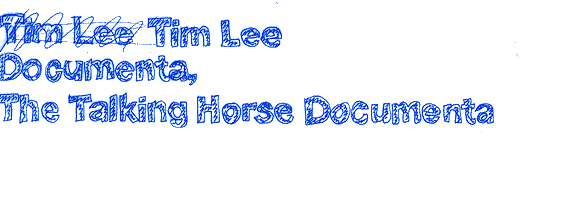|
|
|
|
|
|
A new window has opened. If it has not please click here. |

Catherine David, Okwui Enwezor, and a horse walk into a bar. The horse suddenly stops and says, "Wait a minute, is this a joke?"
Horses, of course, can’t talk. The idea of a talking equine, though, has its precedents. In the 1950s there was Francis, a talking mule who co-starred with Donald O’Connor in a series of films about a military man who meets a mule who can speak. Francis was followed in the 1960s by Mister Ed, a classic American TV sitcom that featured a horse who could not only talk, but also fly an airplane, throw parties, meet celebrities, and ride a surfboard. The following two decades were mostly a creative lull in the talking horse genre, but in 1998 Steve Martin revived the tradition by writing a series of short stories featuring Toby the Talking Horse. Charming and philosophical, Toby would look at art, compose anagrams in his head, and ask the big question: “Does God exist?” Martin debuted his creation in the “Shouts and Murmurs” section of The New Yorker. In November 2002 the same magazine published “What’s so Funny?,” an article by Tad Friend in which the author researched a scientific attempt to discover why we laugh. One of the many assumptions the scientists began with was the “Incongruity Theory,” a humor doctrine devised in the seventeenth century by Blaise Pascal, who wrote, “Nothing produces laughter more than a surprising disproportion between that which one expects and that which one sees.” According to this notion, our pleasure arises in two stages: surprise, then coherence. The article also states that there’s nothing worse than having a joke explained, but according to the Incongruity Theory, my joke above is realized not only through the anomaly of the talking horse, but also through the incongruous notion of Catherine David and Okwui Enwezor appearing as bit-players in a stupid one-liner.
Nevertheless, as we well know, Documenta has always been associated with the serious, the solemn, and the sincere. If David’s Documenta 10 was understood as helping to generate the contemporary debate on the relationship between art and politics, Enwezor’s 11th version worked to advance – and also, in a certain way, redeem - the arguments of the former by globalizing its potential. In either case, the concerns of art are explicitly squared with polemics. Drawing from particular responses to “the unifying processes of global modernity,” and "the postcolonial aftermath of globalization and the terrible nearness of distant places,” each exhibition was fully distinguished by a curatorial attempt to isolate specific strands of artistic production as fervent acts of political commentary. Serious subjects, for sure. But if the art presented was indeed relevant and political, exactly as promised, our sense of the importance, even the necessity, of art that was prescriptive of the world’s problems makes the felt melancholy of these exhibitions especially keen.
¶ 02/02All of this is not necessarily a bad thing. In many ways I’m all for art that is political, and in historical moments where major world problems inevitably offer up artistic imperatives, things need to be said. But, for me at least, art driven solely by politics risks becoming pedantic and overtly didactic; and as an artist I’ve always identified with art that takes its relationship with social subjects as an operative challenge to avoid the obvious. How can art be earnest without being misanthropic? How can one make polemical art that does not appear to be polemical?
My prospectus for a Documenta would include humor as the primary agent for social commentary. With comic devices that include farce, satire, slapstick, sight-gags, and one-liners, this exhibition would showcase art that uses the strategy of comedy not only to dramatize polemical narratives but also to investigate how humor can represent new forms of social, political, and aesthetic freedom. Key to this is the affect of laughter. Laughter, in its many pretexts, can express stupidity, infantilism, repression, contempt, and violence, while its results can verge from simple pleasure to something approaching anarchy. As associated with notions of subversion, rebellion, rebirth, and liberty, comedy in art is often used as a rhetorical tool to protest against the regimentation of the modern world as it simultaneously upends the hegemony in the art world - the last of which may be the subject of my own joke of a curatorial premise. To call something a joke is to dismiss it, while also acknowledging that the object somehow resists the dominant system. In a strange way, this makes my idea all the more inevitable. Supplanting one thought for another; if the next Documenta is about comedy, the one after that can only revert back to tragedy.
xxxxxxxxxxxxxxxxxxxx